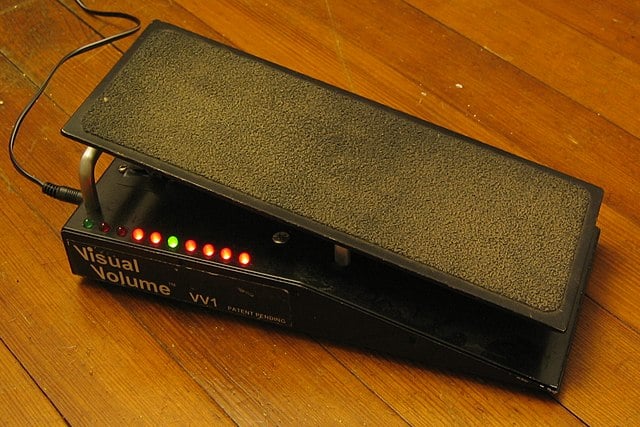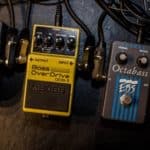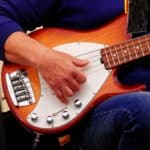Adding a volume pedal to your guitar rig might be one of the most useful choices you could make.
Having the ability to tweak the loudness of your output while you have your hands busy playing might be incredibly convenient at times.
And, of course, just stepping it back when you need complete silence on the stage is great for keeping things tidy.
Finally, if you are someone who likes dialing in the perfect volume setting on your guitar, having a master volume at your feet is a must-have.
But when deciding on which kind of volume pedal to get, there’s a clear choice to be made.
Should you get an active volume pedal or a passive one?
What are their differences and which is better?
What sets apart passive and active volume pedals is that the latter have an amplifier circuit incorporated that allows them to act also as a buffer. This is to prevent the common issue from passive ones of causing tone loss due to the nature of how potentiometers work.
In this article, I will lay out everything there is to know about these 2 kinds of volume pedals, how they work, and what things they do best.
After leaving this page, you will have a clear notion of which might work out better for you based on your play style and your needs.
Are you ready to get started?
Let’s go!
What are passive volume pedals?
Passive volume pedals are one of the simplest kinds of guitar pedals on the market.
You can think of them as regular volume potentiometers being worked with a different mechanism.
No different from what your guitar already has in the form of a knob.
This mechanism, in most cases, is an expression pedal, pretty similar to the ones used on wahs.
If you look at them, you will notice that these kinds of pedals don’t require any kind of power to work, again, such as guitar volume potentiometers.
This makes them very practical to be run on almost any rig.
But you might be wondering what’s the point of having just another volume control so close in the chain to your guitar?
Well, there are many reasons for having them, one that comes to my mind is to allow players to tweak the volume knob on their guitars to a sweet spot they prefer, and leave it there, while still having control over volume with the pedal, without losing that setup.
Also, they are convenient for doing volume swells or for muting the chain quickly with just a stomp.
But on the flip side, passive volume pedals that have a tuner out might end up causing tone loss because of the limitations of their passive circuitry.
And, what’s more, this kind of electronics doesn’t have any way of preventing further tone issues, as the signal flows through the rig since they don’t have any kind of buffer.
Potentiometers, even when at their minimum setting offer some sort of resistance, so without any kind of boost in the chain, they can end up being problematic.
What are active volume pedals?
To begin with, it’s very common to confuse what active volume pedals actually are, because many people use the same term for 2 different things.
These things are passive volume pedals for active pickups and volume pedals with active circuits.
As you can figure, these are completely different concepts.
Passive volume pedals designed exclusively for active pickups are just like any other volume pedal, but with the small difference of using a potentiometer of a lower value because of how active pickups work.
Without going into great detail, while passive pickups usually run with 250k to 500k potentiometers due to their output being of high impedance, active pickups, which output a low impedance signal commonly use 25k pots.
Using higher pot values with active pickups will make them sound extremely bright.
So, now that we have the first part of this confusion covered, let’s follow with what active volume pedals actually are.
What makes a volume pedal “active” is the incorporation of circuitry other than a potentiometer that requires a source of power to function, and that adds certain features.
Active volume pedals have an amplifier circuit that works as a buffer, and can sometimes even work as a boost or to isolate a tuner output.
They are usually powered by an internal battery or hooked up to an external power supply.
As you might know, by now, the utility of having a buffer in your signal chain is preventing what’s known as “tone suck” that ultimately makes you lose high-end as the signal deteriorates in its travel towards the amp.
What’s the main difference between active and passive volume pedals?
The main difference between active and passive volume pedals is that passive ones are just a potentiometer in a pedal form factor that without proper consideration might end up causing some tone loss in your rig.
Active volume pedals make up for this issue by incorporating an amplifier circuit that works as a buffer and can have a boosting function.
This makes them require some sort of internal or external power but prevents the loss of brightness on your guitar tone if your pedal chain is particularly long and has no other buffers.
Are active volume pedals better?
Active volume pedals are not necessarily better.
They just fill a gap on some players’ pedalboards where they don’t have any other buffer before or after the volume pedal.
Although some come with boosting functionality, there’s nothing that you couldn’t get with separate pedals.
Which one should you get?
Deciding on which kind of volume pedal you should get will depend exclusively on what other pedals you have in your rig, and how your signal flows.
If you have some buffered pedals, or even better, a standalone buffer in your chain, a passive volume pedal might work just fine for you.
If on the other side, you perhaps have a more modest pedalboard with mostly true bypass pedals, an active volume pedal could work out for you acting also as a buffer so you can kill two birds with one stone.

Hello there, my name is Ramiro and I’ve been playing guitar for almost 20 years. I’m obsessed with everything gear-related and I thought it might be worth sharing it. From guitars, pedals, amps, and synths to studio gear and production tips, I hope you find what I post here useful, and I’ll try my best to keep it entertaining also.





